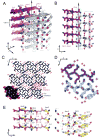Nanotools for megaproblems: probing protein misfolding diseases using nanomedicine modus operandi
- PMID: 17022621
- PMCID: PMC1880889
- DOI: 10.1021/pr0603349
Nanotools for megaproblems: probing protein misfolding diseases using nanomedicine modus operandi
Abstract
Misfolding and self-assembly of proteins in nanoaggregates of different sizes and morphologies (nanoensembles, primary nanofilaments, nanorings, filaments, protofibrils, fibrils, etc.) is a common theme unifying a number of human pathologies termed protein misfolding diseases. Recent studies highlight increasing recognition of the public health importance of protein misfolding diseases, including various neurodegenerative disorders and amyloidoses. It is understood now that the first essential elements in the vast majority of neurodegenerative processes are misfolded and aggregated proteins. Altogether, the accumulation of abnormal protein nanoensembles exerts toxicity by disrupting intracellular transport, overwhelming protein degradation pathways, and/or disturbing vital cell functions. In addition, the formation of inclusion bodies is known to represent a major problem in the production of recombinant therapeutic proteins. Formulation of these therapeutic proteins into delivery systems and their in vivo delivery are often complicated by protein association. Thus, protein folding abnormalities and subsequent events underlie a multitude of human pathologies and difficulties with protein therapeutic applications. The field of medicine therefore can be greatly advanced by establishing a fundamental understanding of key factors leading to misfolding and self-assembly responsible for various protein folding pathologies. This article overviews protein misfolding diseases and outlines some novel and advanced nanotechnologies, including nanoimaging techniques, nanotoolboxes and nanocontainers, complemented by appropriate ensemble techniques, all focused on the ultimate goal to establish etiology and to diagnose, prevent, and cure these devastating disorders.
Figures





References
-
- Cohen AS. General introduction and a brief history of the amyloid fibril. In: Marrink J, Van Rijswijk MH, editors. Amyloidosis. Martinus Nijhoff; Dordrecht, The Netherlands: 1986. pp. 3–19.
-
- Virchow R. Cellulose-Frage. Virchows Arch Pathol Anat. 1854;6:416–426.
-
- Friedreich NK, Zur Amyloidfrage A. Virchows Arch Pathol Anat. 1859;15:50–65.
-
- Hanssen O. Ein Beitrag zur Chemie der amyloiden Entartung. Biochem Z. 1908;13:185–198.
-
- Alzheimer A. Über eine eigenartige Eskrankung der Nirnrinde. Allg Z Psychiatr Psych-Gerichtl. 1907;64:146–148.
Publication types
MeSH terms
Grants and funding
LinkOut - more resources
Full Text Sources
Medical

